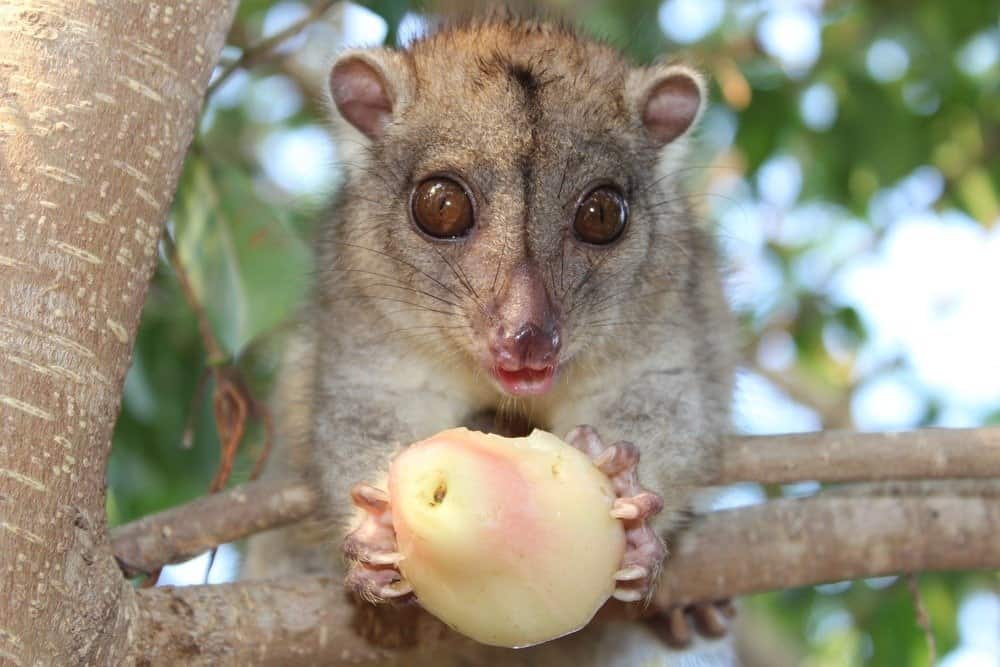Cuscus
.jumbotron {
background-image: url(“https://a-z-animals.com/media/animals/images/original/cuscus5-400×300.jpg”);
}
}
@media only screen and (min-width: 641px) and (max-width: 920px) {
.jumbotron {
background-image: url(“https://a-z-animals.com/media/animals/images/original/cuscus5-470×370.jpg”);
}
}
@media only screen and (min-width: 921px) {
.jumbotron {
background-image: url(“https://a-z-animals.com/media/animals/images/original/cuscus5.jpg”);
}
}
Has a long, strong prehensile tail!
Cuscus Scientific Classification
- Kingdom
- Animalia
- Phylum
- Chordata
- Class
- Mammalia
- Order
- Marsupialia
- Family
- Phalangeridae
- Genus
- Phalanger
- Scientific Name
- Phalanger maculatus
Read our Complete Guide to Classification of Animals.
Cuscus Conservation Status
Cuscus Facts
- Main Prey
- Fruit, Leaves, Insects
- Distinctive Feature
- Long tail and strong toes
- Habitat
- Tropical rainforest and mangroves
- Predators
- Snakes, Humans, Large birds of prey
- Diet
- Herbivore
- Average Litter Size
- 2
- Lifestyle
-
- Solitary
- Favorite Food
- Fruit
- Type
- Mammal
- Slogan
- Has a long, strong prehensile tail!
This post may contain affiliate links to our partners like Chewy, Amazon, and others. Purchasing through these helps us further the A-Z Animals mission to educate about the world’s species..

Spiders that fly! Fish that walk! And 1000+ more incredible animals. Discover them all for FREE
.photo-gallery {
–margin: 0px auto 0px;
–padding: 0px 0px 0px 0px;
}
.gallery-link {
background-image: url(“https://a-z-animals.com/media/animals/images/original/cuscus5.jpg”);
background-repeat: no-repeat;
background-size: cover;
background-position: center;
height: 500px;
justify-content: center;
text-align: center;
align-items: center;
display: flex;
border: 2px solid #000;
}
.gallery-link img {
height: 50%;
}
@media only screen and (max-width: 768px) {
.gallery-link {
height: 300px !important;
}
}
View all of the Cuscus images!
“A baby cuscus stays in its mother’s pouch for up to 7 months”
The common spotted cuscus is a large possum that lives in the tropical lowland forests in New Guinea. This animal is a herbivore with a diet of different types of leaves. A female has a pouch for carrying its young like a kangaroo. The pronunciation of cuscus sounds like cuss-cuss. This animal lives up to 11 years old in the wild.
5 Incredible Cuscus Facts!
- There are 26 species of these marsupials.
- The cuscus is an animal that can live up to 11 years in the wild.
- Because this animal eats a diet of leaves it is sometimes called a folivore.
- Predators of these animals include eagles, pythons, and humans.
- These marsupials are 20 to 22 inches in length.
Cuscus Scientific Name
Spilocuscus maculatus is the scientific name for a common spotted cuscus. The word maculatus is Latin meaning spotted while spilocuscus is the genus of this animal.
Another name for this animal is white cuscus. It belongs to the Phalangeridae family and the class Mammalia.
There are 26 species of these marsupials. Some of those include:
- Blue-eyed spotted cuscus
- Waigeo cuscus
- Admiralty cuscus
- Small Sulawesi cuscus
Cuscus Appearance & Behavior
The male common spotted cuscus is an animal with thick, brownish-red fur with white splotches while females have gray or white fur without any spots.
This animal weighs from 6 to 13 pounds. Their body length ranges from 20 to 22 inches. A 13-pound cuscus weighs the same as a gallon can of paint. A 21-inch-long animal is equal in length to one and a half bowling pins.
This marsupial’s hairless tail measures from 12 to 17 inches long. The animal uses its tail to grasp the branches of a tree to help it climb.
One of the most interesting facts about them is it can have eyes that are blue, red, or orange depending on their species. In addition to having colorful eyes, they have vertical pupils. This gives their eyes an appearance similar to that of a snake or a cat. The design of the animal’s eyes allows it to see at night.
This animal has long nails on its feet that help it to climb trees and move from branch to branch in the treetops. They also use their nails for grooming.
The largest species of cuscus is the Sulawesi bear cuscus. They get their name from its thick coat resembling a bear’s fur. This marsupial weighs up to 15 pounds.
The smallest member of the cuscus family (Phalangeridae) is the Small Sulawesi cuscus. It weighs a little over 2 pounds.
The common spotted cuscus hides from predators among the leaves and branches in its environment. This is its main defense against threats.
These marsupials are solitary animals. Normally, they are shy creatures and try to stay hidden most of the time. However, a male can become aggressive if another male enters its territory. Males mark their territory using a liquid sprayed from their scent glands. Also, they lick twigs and sticks within their territory as a signal for another cuscus to stay away.
If one male enters another male’s territory, the animal occupying the territory may kick, bite or hiss at the trespassing marsupial.

Meli.Stock/Shutterstock.com
Cuscus Habitat
These animals live in New Guinea as well as Cape York in Australia. Specifically, they live in trees in tropical forests, hardwood forests, and mangroves. Cuscus that live in mangroves migrates to tropical forests for the winter season.
These marsupials build homes in the hollows of trees or create platforms or nests high in the treetops where they can sleep.
They live in a warm, wet climate. The animal may sit under a large collection of leaves to cool off when it’s extremely hot. Or they sometimes crawl into a hollow log for shade during the hottest part of the day.
Cuscus Diet
What does a cuscus eat?
These animals are herbivores eating leaves and fruit. Some biologists refer to cuscus as folivores because their main diet is leaves. Folium is a Latin word meaning leaf and the word voro means devour (eat). Since cuscus lives in the treetops, leaves are easily accessible and don’t require them to risk going to the forest floor to search for food.
Cuscus Predators and Threats
What eats the cuscus?
Predators of these animals include eagles, pythons, and humans.
Poaching is a threat to these animals. One of the most discouraging facts is they are hunted by humans for food. Also, hunters sometimes use their skin to make clothing and other items.
Habitat loss is also a threat. Deforestation takes away the trees where these animals live and reproduce.
Despite these threats, the official conservation status of the common spotted cuscus is Least Concern. Their population is categorized as stable.
Cuscus Reproduction, Babies and Lifespan
The animal breeds at any time throughout the year and has multiple partners. Though not much is known about their mating rituals, biologists have observed cuscus males and females making clicking, screeching, and hissing sounds during the courtship period.
The gestation period of a female range from 20 to 42 days. Compare this to another member of the Phalangeridae family, the common brushtail possum. A female common brushtail possum’s gestation period ranges from 16 to 18 days.
A cuscus can have from 1 to 4 babies, but the average number of offspring is 2. A newborn weighs less than an ounce. They are born blind, deaf, and without fur. The babies have to find their way by smell and touch into their mother’s pouch to nurse. Any baby that’s not strong enough to find and latch onto its mother’s teat to drink milk will die. The babies are called joeys.
The joeys are weaned at about 5 or 6 months. But they stay in their mother’s pouch for up to 7 months before becoming independent. Some animals have been known to return to their mother’s pouch even after they are weaned. The father doesn’t have a role in raising the joeys.
These animals reach sexual maturity at one year old. These animals can live up to 11 years in the wild.
Cuscus Population
The exact population of the common spotted cuscus is unknown. But, its conservation status is Least Concern. Its population is reported as stable.
View all 157 animals that start with C
Cuscus FAQs (Frequently Asked Questions)
Are cuscus carnivores, herbivores, or omnivores?
Cuscuses are herbivores with a diet of leaves and fruit. Sometimes they are called folivores because of their diet of leaves.
What is a cuscus?
A cuscus is a large possum. This animal lives in tropical forests, hardwood forests, and mangroves. They are from New Guinea and Cape York on the continent of Australia. They are marsupials (like kangaroos) carrying their young in a front-facing pouch.
What does a cuscus look like?
A male common spotted cuscus has brown/red thick fur with white spots. A female has solid gray or brown fur without spots. One of the most notable features of this possum is its eyes. Cuscus can have blue, orange, or red eyes. In addition, these animals have vertical pupils like a snake or a cat. Another notable feature of this animal is its tail. It’s hairless and can curve around branches like an extra leg. A cuscus’ tail and long claws/nails help it to climb trees and jump between branches.
Is a cuscus endangered?
It depends on the species. The common spotted cuscus is categorized as Least Concern with a stable population.
Another species called the blue-eyed spotted cuscus is listed as Critically Endangered with a decreasing population. Its population is threatened by poaching activity and loss of habitat due to deforestation.
What is the proper pronunciation of cuscus?
The proper pronunciation of cuscus is easy to learn if you remember it sounds like you’re saying, ‘cuss-cuss.’
What does a cuscus eat?
A cuscus eats leaves and fruit. The types of leaves or fruit it eats depends on the food source that’s most abundant in its habitat. In short, a cuscus eats whatever plants or fruit are most plentiful in its living environment.
What Kingdom do Cuscus belong to?
Cuscus belong to the Kingdom Animalia.
What phylum do Cuscus belong to?
Cuscus belong to the phylum Chordata.
What class do Cuscus belong to?
Cuscus belong to the class Mammalia.
What family do Cuscus belong to?
Cuscus belong to the family Phalangeridae.
What order do Cuscus belong to?
Cuscus belong to the order Marsupialia.
What genus do Cuscus belong to?
Cuscus belong to the genus Phalanger.
What type of covering do Cuscus have?
Cuscus are covered in Fur.
In what type of habitat do Cuscus live?
Cuscus live in tropical rainforests and mangroves.
What are some predators of Cuscus?
Predators of Cuscus include snakes, humans, and large birds of prey.
How many babies do Cuscus have?
The average number of babies a Cuscus has is 2.
What is an interesting fact about Cuscus?
The Cuscus has a long, strong prehensile tail!
What is the scientific name for the Cuscus?
The scientific name for the Cuscus is Phalanger maculatus.
What is the lifespan of a Cuscus?
Cuscus can live for 8 to 12 years.
How fast is a Cuscus?
A Cuscus can travel at speeds of up to 15 miles per hour.
How to say Cuscus in …
Cuscús tacat
Kuskus skvrnitý
Eigentlicher Tüpfelkuskus
Common Spotted Cuscus
Spilocuscus maculatus
Spilocuscus maculatus
Foltos kuszkusz
Gevlekte koeskoes
Kuskus plamisty
Spilocuscus maculatus
Täpläkuskus
斑袋貂
Sources
- Animal Diversity Web, Available here: https://animaldiversity.org/accounts/Spilocuscus_maculatus/
- Wikipedia, Available here: https://en.wikipedia.org/wiki/Common_spotted_cuscus
- EDGE, Available here: http://www.edgeofexistence.org/species/blue-eyed-spotted-cuscus/
















